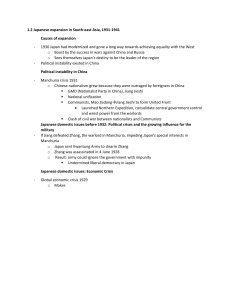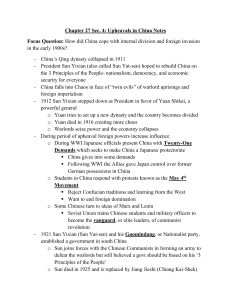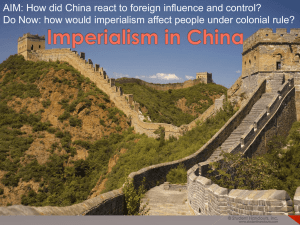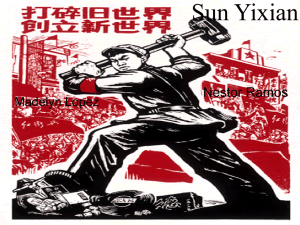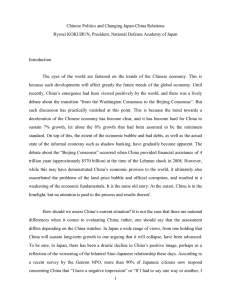December 1 , 2015 PDN British government, following the Amritsar
advertisement
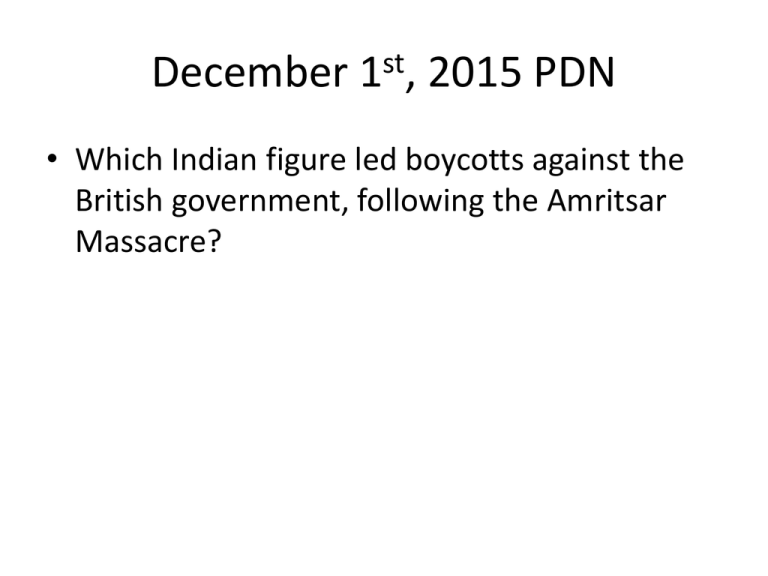
December 1st, 2015 PDN • Which Indian figure led boycotts against the British government, following the Amritsar Massacre? 8.4 New Forces in China and Japan Objectives: Explain the key challenges faced by the Chinese republic in the early 1900s. Analyze the struggle between nationalists and Communists in China. Summarize the effects of liberal changes in Japan in the 1920s. Objectives Continued… • Describe the rise of extreme nationalism and militarism in Japan. • Describe the impact of the Japanese invasion of China. China China’s flag today (below) Republic of China 1917-1928 ^^^^^ Where in the World is China??? Yes, Right there. Trouble in the Chinese Republic • Sun Yixian - “Father of Modern China” – Three Principles of the People • Nationalism • Democracy • Economic security for everyone – Made little progress in rebuilding China. • Chinese people felt more loyalty to families and clans instead of their nation. • “Therefore, even though we have four hundred million people gathered together in one China, in reality they are just a heap of loose sand. Today we are the poorest and weakest nation in the world and occupy the lowest position in international affairs. Other men are the carving knife and serving dish, we are the fish and the meat.” - Sun Yixian Trouble Continued… • 1912, Sun stepped down as president in favor of Yuan Shikai. • Yuan tried to set up a Dynasty, but military did not support him. • Opposition divided nation, China plunged into greater disorder. • In provinces, local warlords seized power. – Rival armies battled for control. – Economy collapsed. – Millions of peasants suffered terrible hardships. – Famine and attacks by bandits added to misery. Foreign Imperialism • Chaos led to weakness. • Foreign countries increased their influence in China. • Japan presents China with the Twenty-One Demands at the beginning of World War I. • Too weak to resist, the Chinese gave in to demands. • Following WWI, Allies gave the Japanese control of former German possessions in China. (Yes, they were tight). The May Fourth Movement Seeks Reform • Student protests erupted in Beijing on May 4th, 1919 and spread across China. • Students organized boycotts of Japanese goods and businesses. • Women played key role. – Campaigned to end traditional practices, such as footbinding and the seclusion of women within the home. Chinese Communism is Born • Some Chinese turned to revolutionary ideas of Marx and Lenin. – Soviet Union (Russians) trained Chinese students and military officers to become the vanguard. – By 1920s, small Communist Political Party is born in China The Nationalists and Jiang Jieshi • Jiang Jieshi took over after Sun’s death, he was determined to reunite China (no interest in Democracy nor Communism). • 1927, Jiang orders the slaughter of Communist Party members… starting a 22 year civil war. Continued… • Mao Zedong escaped Jiang’s attacks. – Believed communists should seek support from peasants – Redistributed land to peasants and offered them schooling and health care in southeastern China. The Long March • From 1934 to 1935, 100,000 Communists trekked more than 6,000 miles across the rugged mountains and raging rivers of China. • Faced daily attacks, only about 20,000 survived. China Faces Japanese Imperialism
